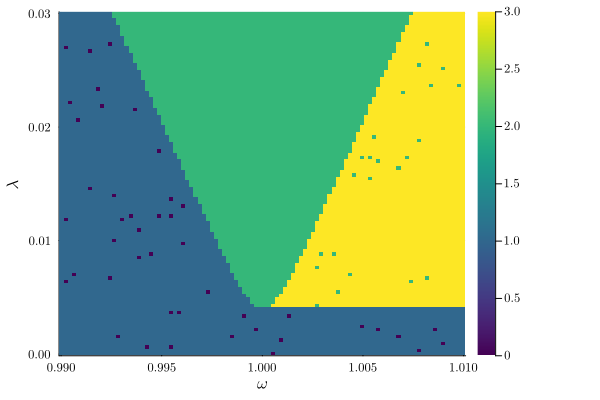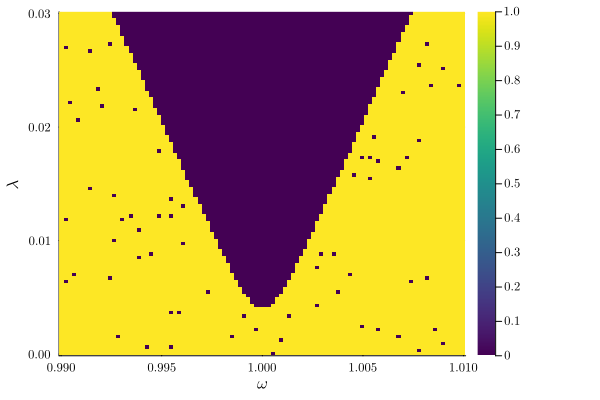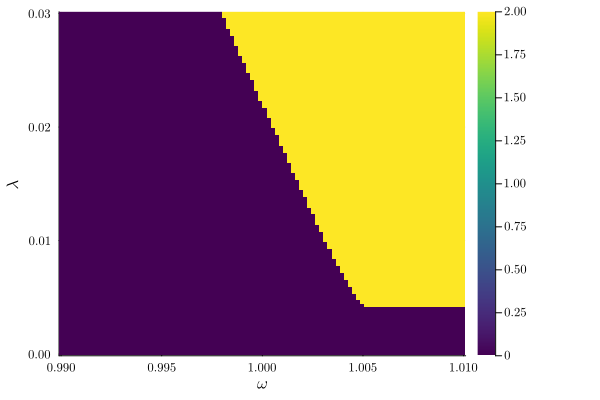Classifying solutions
Given that you obtained some steady states for a parameter sweep of a specific model it can be useful to classify these solution. Let us consider a simple pametric oscillator
using HarmonicBalance
@variables ω₀ γ λ α ω t x(t)
natural_equation = d(d(x, t), t) + γ * d(x, t) + (ω₀^2 - λ * cos(2 * ω * t)) * x + α * x^3
diff_eq = DifferentialEquation(natural_equation, x)
add_harmonic!(diff_eq, x, ω);
harmonic_eq = get_harmonic_equations(diff_eq)A set of 2 harmonic equations
Variables: u1(T), v1(T)
Parameters: ω, α, γ, ω₀, λ
Harmonic ansatz:
x(t) = u1(T)*cos(ωt) + v1(T)*sin(ωt)
Harmonic equations:
-(1//2)*u1(T)*λ + (2//1)*Differential(T)(v1(T))*ω + Differential(T)(u1(T))*γ - u1(T)*(ω^2) + u1(T)*(ω₀^2) + v1(T)*γ*ω + (3//4)*(u1(T)^3)*α + (3//4)*u1(T)*(v1(T)^2)*α ~ 0
Differential(T)(v1(T))*γ + (1//2)*v1(T)*λ - (2//1)*Differential(T)(u1(T))*ω - u1(T)*γ*ω - v1(T)*(ω^2) + v1(T)*(ω₀^2) + (3//4)*(u1(T)^2)*v1(T)*α + (3//4)*(v1(T)^3)*α ~ 0We perform a 2d sweep in the driving frequency
fixed = (ω₀ => 1.0, γ => 0.002, α => 1.0)
varied = (ω => range(0.99, 1.01, 100), λ => range(1e-6, 0.03, 100))
result_2D = get_steady_states(harmonic_eq, varied, fixed)A steady state result for 10000 parameter points
Solution branches: 5
of which real: 5
of which stable: 3
Classes: stable, physical, Hopf, binary_labelsBy default the steady states of the system are classified by four different catogaries:
physical: Solutions that are physical, i.e., all variables are purely real.stable: Solutions that are stable, i.e., all eigenvalues of the Jacobian have negative real parts.Hopf: Solutions that are physical and have exactly two Jacobian eigenvalues with positive real parts, which are complex conjugates of each other. The class can help to identify regions where a limit cycle is present due to a Hopf bifurcation. See also the tutorial on limit cycles.binary_labels: each region in the parameter sweep receives an identifier based on its permutation of stable branches. This allows to distinguish between different phases, which may have the same number of stable solutions.
We can plot the number of stable solutions, giving the phase diagram
plot_phase_diagram(result_2D, class="stable")
If we plot the a cut at
plot(result_2D, y="√(u1^2+v1^2)", cut=λ => 0.01, class="stable") |> displayget_single_solution(result_2D; branch=1, index=(1, 1))OrderedCollections.OrderedDict{Num, ComplexF64} with 7 entries:
u1 => 2.23265e-203-2.23265e-203im
v1 => 3.69982e-202-2.36023e-202im
ω => 0.99+0.0im
λ => 1.0e-6+0.0im
ω₀ => 1.0+0.0im
γ => 0.002+0.0im
α => 1.0+0.0imThis solution becomes stable again outside the green lobe. Also called Mathieu lobe. Indeed, we can classify the zero amplitude solution by adding an extra category as a class:
classify_solutions!(result_2D, "sqrt(u1^2 + v1^2) < 0.001", "zero")
result_2DA steady state result for 10000 parameter points
Solution branches: 5
of which real: 5
of which stable: 3
Classes: zero, stable, physical, Hopf, binary_labelsWe can visualize the zero amplitude solution:
plot_phase_diagram(result_2D, class=["zero", "stable"])
This shows that inside the Mathieu lobe the zero amplitude solution becomes unstable due to the parametric drive being resonant with the oscillator.
We can also visualize the equi-amplitude curves of the solutions:
classify_solutions!(result_2D, "sqrt(u1^2 + v1^2) > 0.12", "large amplitude")
plot_phase_diagram(result_2D, class=["large amplitude", "stable"])